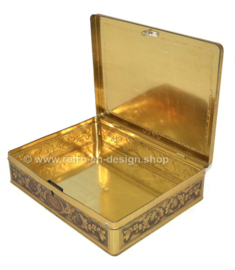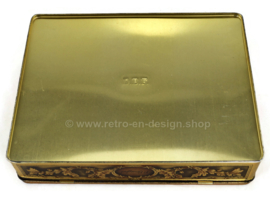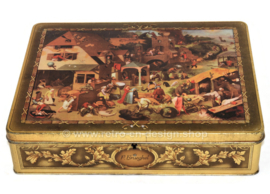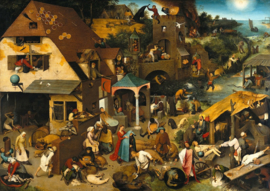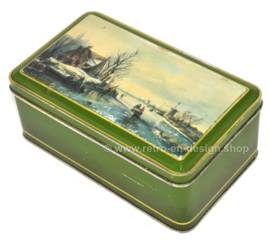SOLD
Rectangular vintage DBF tin with painting "Netherlandish proverbs" by Pieter Brueghel
SKU: BT-2980-20Rectangular vintage DBF tin with painting "Netherlandish proverbs" by Pieter Brueghel.
- Manufacturer: DBF
- Manufacturing date: 1980 - 1990
Description
Large tin box produced by DBF and equipped with a hinged lid. On the lid the famous painting "Proverbs" by Pieter Brueghel from 1559. The decoration of the tin also consists of a gold-coloured background with details in brown. The tin has a lock hole on the front. Unfortunately, the key is missing.
Text on the edge of the back of the lid: Etabl. J. Schuybroek s.r. Hoboken-Anvers
Condition
This tin is in a good vintage condition with normal traces of use and age-related traces of wear. Pictures are part of the description.
Size
- Height: 6.5 cm.
- Length: 29.3 cm.
- Width: 22.3 cm.
Netherlandish Proverbs (Dutch: Nederlandse Spreekwoorden; also called Flemish Proverbs, The Blue Cloak or The Topsy Turvy World) is a 1559 oil-on-oak-panel painting by Pieter Bruegel the Elder that depicts a scene in which humans and, to a lesser extent, animals and objects, offer literal illustrations of Dutch-language proverbs and idioms.
Running themes in Bruegel's paintings are the absurdity, wickedness and foolishness of humans, and this is no exception. The painting's original title, The Blue Cloak or The Folly of the World, indicates that Bruegel's intent was not just to illustrate proverbs, but rather to catalog human folly. Many of the people depicted show the characteristic blank features that Bruegel used to portray fools.
His son, Pieter Brueghel the Younger, specialized in making copies of his father's work and painted at least 16 copies of Netherlandish Proverbs. Not all versions of the painting, by father or son, show exactly the same proverbs, and they also differ in other minor details.
The painting, dated 1559, is considered the best of a series of similar paintings which at one time or other have all previously been attributed to Pieter Bruegel the Elder, has been x-rayed for its underdrawing to compare it to other versions. None of the versions have a provenance going back further than the late 19th-century, but Brueghel scholars believe that the paintings are the elder Bruegel's inventions, which all make use of a life-size cartoon with the same underdrawing as that used in the Berlin version. The paintings, which are not inscribed, tease the viewer into guessing proverbs. They are based on 1558 and earlier engravings that are inscribed, in Flemish. The most notable of these regarding the paintings is by Frans Hogenberg, and it is dated 1558 and accompanied by the title Die blau huicke is dit meest ghenaemt, maer des weerelts abvisen he beter betaempt (English: Often called 'The Blue Cloak', this could better be called 'The World's Follies'). The Doetecum brothers produced a print series in 1577 called De Blauwe Huyck. Theodoor Galle also made a print, dated later, with a similar title: Dese wtbeeldinghe wort die blauw hvyck genaemt, maer deze werelts abvysen haer beter betaemt.
Pieter Bruegel (also Brueghel or Breughel) the Elder 1525–1530 – 9 September 1569) was the most significant artist of Dutch and Flemish Renaissance painting, a painter and printmaker, known for his landscapes and peasant scenes (so-called genre painting); he was a pioneer in making both types of subject the focus in large paintings.
He was a formative influence on Dutch Golden Age painting and later painting in general in his innovative choices of subject matter, as one of the first generation of artists to grow up when religious subjects had ceased to be the natural subject matter of painting. He also painted no portraits, the other mainstay of Netherlandish art. After his training and travels to Italy, he returned in 1555 to settle in Antwerp, where he worked mainly as a prolific designer of prints for the leading publisher of the day. Only towards the end of the decade did he switch to make painting his main medium, and all his famous paintings come from the following period of little more than a decade before his early death, when he was probably in his early forties, and at the height of his powers.
As well as looking forwards, his art reinvigorates medieval subjects such as marginal drolleries of ordinary life in illuminated manuscripts, and the calendar scenes of agricultural labours set in landscape backgrounds, and puts these on a much larger scale than before, and in the expensive medium of oil painting. He does the same with the fantastic and anarchic world developed in Renaissance prints and book illustrations.
He is sometimes referred to as "Peasant Bruegel", to distinguish him from the many later painters in his family, including his son Pieter Brueghel the Younger (1564–1638). From 1559, he dropped the 'h' from his name and signed his paintings as Bruegel; his relatives continued to use "Brueghel" or "Breughel".
Some translations come from an automated system and may contain errors.
Country of origin
Belgium (Anvers)
Kind of object
Tin drum - tin box - tin
Theme
Pieter Brueghel - Netherlandish Proverbs - painting
Category
Vintage tins
Color
Gold-coloured - brown - multi-coloured
Publisher
Etabl. J. Schuybroek s.r. Hoboken-Anvers
Manufacturer
DFB
Brand
DFB
Material
Tin - metal
Particularities
Hinged lid - Painting "Netherlandish Proverbs" on the lid
Era
1980 - 1990
Quality
Good vintage condition
Height
6,50 cm
Lenght
29,30 cm
Width
22,30 cm
Shipping method
Parcel post with track & trace










